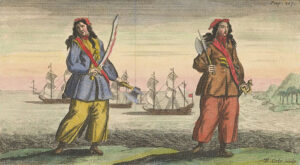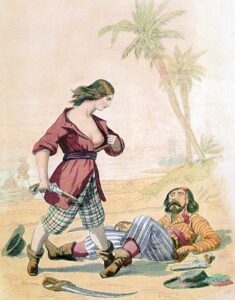Female pirates and punk icons
by Julie Walker
“Bonny & Read has it all. Adventure, atmosphere, sizzling suspense and unforgettable characters. Such a brilliant debut!” S.D. Sykes, author of The Good Death
In 1981, six months before the ill-fated wedding of Prince Charles and Lady Diana Spencer, Vivienne Westwood staged her first fashion show in collaboration with her partner Malcolm McLaren. The name of the collection: Pirates. With bravado and swagger at the core of the collection, the show was a huge success, both critically and financially.
Westwood and McLaren were the creative masterminds behind punk – the anarchistic movement that had spawned the Sex Pistols (managed by McLaren and dressed by Westwood) and more in the year of the Queen’s Silver Jubilee in 1977. But four years on, the world was a different place and new inspiration was needed.
If punk had been anti-fashion, Pirates was its opposite. With soft, flowing looks “for heroes” as the look was dubbed, it came from Westwood’s fascination with the outsider aesthetic of 18th-century buccaneers, highwaymen and dandies, and traditional Indigenous American dress. Little wonder that Adam Ant adopted the look and made it famous, his music steeped in the same influences. The New Romantic movement followed on soon after, meaning that Westwood was at the helm of the movement’s look.
So why did a clothing collection have such resonance?
Quoted at the time, Adam Ant said: “I think the kids are sick of being thought of as ‘We’re all in the gutter together’, dressing only in black and grey, being the Blank Generation… I like a bit of colour, a bit of flash, a bit of honour, a bit of dash.”
With flowing shirts, roomy trousers nipped in with belts and incredible hats, the androgynous look that typified the Pirates collection could have been taken direct from Anne Bonny and Mary Read – real-life 18th-century pirates themselves. Adam Ant had commemorated the women in the song ‘Five Guns West’, a celebration of women defying societal norms, and they typified the mood of the punk and post-punk age.

Colourised engraving of Anne Bonny and Mary Read from A General History of the Pyrates by Captain Charles Johnson, 1724. Wikimedia Commons
The real pirates of the Caribbean had always used clothing and image to create their personal brands and to make themselves memorable. Blackbeard used to highlight his eyes with kohl (just as Jack Sparrow does in the Disney movies) and tied lit fuses to his beard to terrify his enemies. Captain Jack Rackham, who sailed with Anne and Mary, was known as ‘Calico Jack’ due to the red calico frock coat he always wore. ‘Black Bart’ Roberts, a Welsh pirate, was known for his elaborate hats and large jewelled crucifix, wholly at odds with his bloodthirsty and merciless reputation.
These men took on the excesses of fashion wherever they saw them, and were never knowingly underdressed. The clothes they wore were not meant for any but the moneyed few, but their defiance was shown by wearing them in a brand new way of their own. Clothing was often taken as spoils in raids, and so the pirate look grew organically to encapsulate an all-encompassing view of worldwide fashion. It was both defiant and outrageous, and marked them out as something very new.
If the way we dress ourselves is an expression of character, Anne and Mary’s clothes screamed of alienation – a real world turned upside down.”

Mary Read by Alexandre Debelle, from Histoire des pirates et corsaires de l’Océan et de la Méditerranée by P. Christian, 1846. Wikimedia Commons
For pirate crews, their look was a mixture of the practical and the flamboyant. Not bound by any societal norms, their clothing would automatically stand out in a society where to look like everyone else was a matter of course. That two women became active pirates, adopting the clothing and attitude of their crewmates, would have been a scandal – and so it proved to be. The very existence of Anne Bonny and Mary Read, and how they dressed in trousers and men’s shirts, blew convention out of the water.
Their look was both courageous and extraordinary – as commemorated in Captain Johnson’s History of the Pyrates published in 1724. Ironically, the uniform of men’s clothes they had both adopted for the practicalities of life at sea – and in Mary’s case had been her way to avoid detection as a woman while fighting as a soldier in Flanders and then as a merchant seaman – became the very thing that made them stand out. If the way we dress ourselves is an expression of character, Anne and Mary’s clothes screamed of alienation – a real world turned upside down. Little wonder they became so notorious.
Over the past years it has been interesting to watch how these women continue to capture the imagination of new generations. Whether it is as characters in TV’s Black Sails, in the video game Assassin’s Creed, or in their own comic book A Man Among Ye, it seems that these rebel women have earned a place in our collective mythology. They created mayhem, and stamped themselves onto our psyches while they did it. As a way to be remembered, I think it’s up there with the best.
—
 Julie Walker was accepted onto a Curtis Brown Creative course to work on an early version of her debut novel Bonny & Read,which was longlisted for both the Mslexia First Novel Prize and the Bath Novel Award. Born in the North East, Julie now lives in London with her husband and cat. Bonny & Read is published by Hodder & Stoughton in hardback, eBook and audio download.
Julie Walker was accepted onto a Curtis Brown Creative course to work on an early version of her debut novel Bonny & Read,which was longlisted for both the Mslexia First Novel Prize and the Bath Novel Award. Born in the North East, Julie now lives in London with her husband and cat. Bonny & Read is published by Hodder & Stoughton in hardback, eBook and audio download.
Read more
@NicerMarmot
@HodderBooks
Author portrait © Karolina Heller

